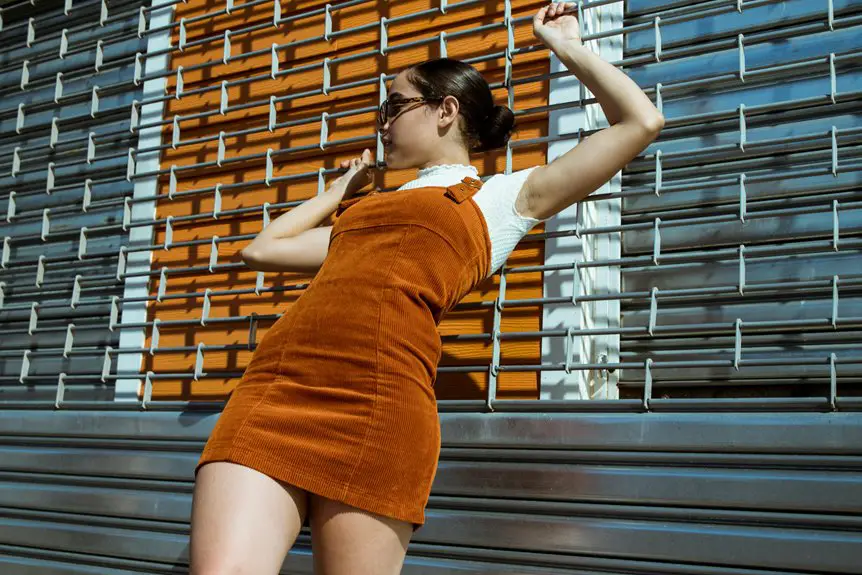To craft a stylish corduroy overall dress, start by picking the right fabric with a comfortable wale size and weight. Take precise measurements of your bust, waist, and torso length for a perfect fit. Use sharp scissors, sewing machine, and matching thread to cut and assemble your pieces carefully. Add unique details like pockets or buttons to personalize your look. Layer and accessorize for versatile styling options. Keep going, and you’ll discover expert tips to make your dress truly stand out.
Table of Contents
Key Takeaways
- Choose corduroy fabric based on wale size, weight, color, and slight stretch for comfort and style.
- Take precise measurements of bust, waist, hips, and torso length for a perfect fit.
- Adjust patterns for strap length and bodice shape, then cut fabric accurately with seam allowances.
- Pre-wash fabric, press seams, and sew with reinforced stitches and finished edges for durability.
- Add pockets, buttons, belts, and layer with tops and accessories to personalize and style the dress.
Choosing the Right Corduroy Fabric for Your Dress
When choosing the right corduroy fabric for your overall dress, consider the texture and weight that suit your style and comfort.
Selecting corduroy fabric involves balancing texture and weight to match your style and comfort preferences.
You’ll find corduroy comes in various wale sizes—from fine to wide ribs. Fine wale offers a smoother, more refined look, while wide wale adds a bold, casual vibe.
Think about the dress’s purpose: lighter fabric works well for warmer days, and heavier corduroy provides warmth and structure for cooler weather.
Also, pay attention to the fabric’s stretch; a slight stretch can enhance comfort and fit.
Finally, choose a color that complements your wardrobe—classic shades like tan, navy, or burgundy are versatile, but don’t hesitate to pick a bright tone if you want your dress to stand out.
Essential Tools and Materials for Sewing
A successful sewing project starts with having the right tools and materials on hand. You’ll need sharp fabric scissors to cut your corduroy cleanly, and pins or clips to hold pieces together. A sewing machine is essential, but don’t forget a matching thread that complements your fabric’s color.
A measuring tape helps you stay precise, while tailor’s chalk or fabric markers let you mark your pattern clearly. You’ll also want a seam ripper for fixing mistakes quickly.
Optional but helpful are an iron and ironing board to press seams flat, making your dress look polished. With these basics ready, you’ll set yourself up for smooth, efficient sewing and a stylish corduroy overall dress you’ll love wearing.
Taking Accurate Measurements for a Perfect Fit
Taking accurate measurements guarantees your corduroy overall dress fits perfectly and feels comfortable all day. Start by measuring your bust, waist, and hips with a flexible tape measure, keeping it snug but not tight. Stand straight and relax your body for the best results.
Accurate measurements ensure your corduroy overall dress fits perfectly and feels comfortable all day.
Measure your torso length from the top of your shoulder down to where you want the dress to end. Don’t forget to note your shoulder width and the distance between your bust points for better shaping.
Write down each measurement immediately to avoid confusion. Double-check every number to prevent errors that can ruin your fit.
Accurate measurements lay the foundation for a flattering overall dress, so take your time and be precise before moving on to pattern drafting.
Drafting and Adjusting the Overall Dress Pattern
Now that you have your measurements, it’s time to draft your overall dress pattern with precision.
Focus on modifying the strap length to suit your height and adjusting the bodice shape for your unique silhouette.
These tweaks guarantee your corduroy dress fits comfortably and looks stylish.
Measuring for Accurate Fit
Two key measurements determine how your corduroy overall dress will fit: your bust and waist. Taking these accurately guarantees comfort and style. Use a soft measuring tape and stand straight, relaxing your body for precise results.
Focus on these areas:
- Bust: Wrap the tape around the fullest part, keeping it parallel to the floor.
- Waist: Measure at your natural waistline, usually the narrowest point above your hips.
- Hip: Though not always critical for an overall dress, knowing your hip measurement helps if your dress flares or fits closely around the lower body.
Record each measurement carefully, then adjust your pattern accordingly. This step avoids fitting issues and makes your sewing experience smoother.
Modifying Strap Length
While adjusting your corduroy overall dress pattern, modifying the strap length is essential to guarantee a comfortable and flattering fit.
Start by wearing a muslin or test garment and mark where the straps naturally sit on your shoulders. Compare this to your original pattern length. If the straps are too long, trim the pattern straps evenly from the top edge, making certain both sides stay symmetrical.
Too short? Add length by extending the strap pattern pieces, blending lines smoothly to avoid sharp edges. Remember to adjust strap attachment points on the bib and back to maintain proper alignment.
Double-check both front and back strap lengths, as uneven straps can cause discomfort or an unbalanced appearance. Taking these steps secures your overall dress fits perfectly and looks polished.
Adjusting Bodice Shape
Because the bodice forms the foundation of your corduroy overall dress, adjusting its shape is essential to achieving a tailored fit. Start by checking the bust, waist, and shoulder measurements against your pattern. Pinch or add fabric where needed to contour the bodice perfectly to your body.
Remember, small tweaks can make a big difference in comfort and style.
Focus on these key adjustments:
- Dart placement: Shift or reshape darts to enhance bust fit without puckering.
- Side seams: Take in or let out seams for a snug or relaxed silhouette.
- Shoulder width: Narrow or widen the shoulder area to prevent slipping straps or tightness.
With these precise tweaks, your overall dress will look polished and feel comfortable.
Cutting Fabric and Preparing for Assembly
Before you start cutting your corduroy, carefully measure and mark your fabric to guarantee accuracy.
Choose sharp scissors or a rotary cutter to get clean edges without fraying.
Don’t forget to prepare your seam allowances properly to make assembly smoother later on.
Measuring and Marking Fabric
Start by carefully measuring and marking your fabric to confirm every piece fits perfectly in your corduroy overall dress.
Accurate measurements confirm your dress will have the right fit and look polished. Use a ruler or measuring tape to note dimensions for each pattern piece. Then, mark the fabric with tailor’s chalk or a fabric marker—something that won’t leave permanent marks.
Keep these tips in mind:
- Double-check measurements before marking to avoid mistakes.
- Mark notches and seam allowances clearly for easy assembly.
- Use straight, visible lines to guide your cutting precisely.
Selecting Cutting Tools
Although selecting the right cutting tools might seem straightforward, choosing sharp scissors or a rotary cutter designed for fabric will make your work cleaner and faster.
Fabric scissors should be reserved solely for cutting fabric to maintain their sharpness. A rotary cutter with a self-healing mat is ideal for straight, precise cuts, especially on thicker corduroy.
Before cutting, verify your tools are sharp and comfortable to handle, as dull blades can snag or distort the fabric. Additionally, use fabric weights or pins to keep your pattern pieces steady while you cut.
Taking these steps will help you achieve smooth, accurate edges, setting a solid foundation for assembling your stylish corduroy overall dress. Proper cutting tools directly impact the quality and ease of your sewing project.
Preparing Seam Allowances
When you cut your fabric, always add seam allowances to confirm your pieces fit together seamlessly during assembly. Seam allowances give you the extra fabric needed to sew pieces without shrinking the overall size of your dress. For corduroy, a typical seam allowance is ⅝ inch (1.5 cm), but check your pattern instructions to be certain.
To prepare your seam allowances effectively:
- Mark the seam lines clearly with tailor’s chalk or fabric markers.
- Clip notches along the edges to help align pieces during sewing.
- Press the allowances flat with an iron to prevent bulky seams later.
These steps confirm your stylish corduroy overall dress comes together perfectly and lasts through wear.
Sewing Techniques for Durable Seams and Finishing
To guarantee your corduroy overall dress withstands frequent wear, you need to use sewing techniques that reinforce seams and provide clean finishes.
Start by stitching with a straight stitch close to the edge, then backstitch at the beginning and end to lock seams securely. For durability, consider using a double seam or flat-felled seam, which encloses raw edges and prevents fraying.
Begin with a straight stitch near the edge, backstitch to lock, and use double or flat-felled seams for durability.
Press your seams open with an iron to reduce bulk and create a crisp look. Finish raw edges with a serger or a zigzag stitch to keep the fabric neat and prevent unraveling.
Finally, topstitch along seams to add strength and a professional touch. These techniques guarantee your dress remains sturdy and polished through everyday use.
Adding Functional and Decorative Details
Once your seams are secure and edges neatly finished, you can enhance your corduroy overall dress by adding functional and decorative details.
These elements not only boost the dress’s practicality but also elevate its style. Think about incorporating features that suit your lifestyle and personal taste.
Here are some ideas to reflect on:
- Pockets: Sew patch or welt pockets for convenience and charm.
- Buttons and Clasps: Use vintage buttons or metal clasps for closures that add character.
- Embroidery or Appliqué: Personalize your dress with subtle embroidery or fabric patches for a unique touch.
Styling Tips to Wear Your Corduroy Overall Dress
A corduroy overall dress offers versatile styling options that can easily shift from casual to chic. You can layer it over a fitted turtleneck or a simple white tee for a relaxed look.
Swap sneakers for ankle boots to instantly elevate your outfit. Don’t hesitate to add a belt to define your waist and add structure.
For colder days, throw on a cozy cardigan or denim jacket. Accessorize with statement jewelry or a colorful scarf to add personality.
When it’s warm, opt for a breezy blouse underneath and pair with sandals. By mixing textures and accessories, you create fresh looks that suit any occasion.
Experiment with different tops, shoes, and layers to make your corduroy overall dress uniquely yours.
Frequently Asked Questions
How Do You Care for and Wash a Corduroy Overall Dress?
You should wash your corduroy overall dress inside out in cold water on a gentle cycle. Avoid bleach, and hang it to dry. Iron on low heat if needed to keep it looking fresh and stylish.
Can Corduroy Overall Dresses Be Worn Year-Round?
You can definitely wear corduroy overall dresses year-round. Layer them with t-shirts in warmer months and sweaters or jackets in colder seasons. Just adjust your accessories and footwear to stay comfortable and stylish anytime.
What Types of Shoes Pair Best With a Corduroy Overall Dress?
When Mia paired her corduroy overall dress with ankle boots, she nailed the look. You’ll love pairing yours with sneakers for casual vibes or heeled boots to dress it up effortlessly.
Are There Eco-Friendly Corduroy Fabric Options Available?
You can find eco-friendly corduroy made from organic cotton or recycled fibers. These options reduce environmental impact while keeping that classic texture. Look for certifications like GOTS to guarantee sustainable sourcing and production.
How Do You Repair Small Tears in Corduroy Fabric?
Think of your corduroy as a garden; small tears are like tiny weeds. You’ll gently stitch them closed or use fabric glue, nurturing the fabric’s rows so they bloom seamlessly once more, keeping your garment whole and strong.
- Does Chiffon Fabric Stink - July 15, 2025
- Does Chiffon Fabric Affect the Economy - July 15, 2025
- Does Cotton Fabric Have a Nap - July 15, 2025







